Numerous publications have lauded The University of Alabama campus as one of the most beautiful in the South.
So what makes the campus so attractive? So iconic?
That’s a question with many answers as noted in the UA Campus Visitors Guide, which shares the top 10 places to strike a pose and capture a memory in photographs.
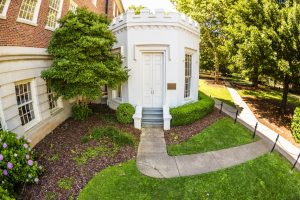
10. The Round House
One of the few buildings to survive the 1865 campus blaze set by the Union Army, the Round House serves as a memorial for all University honor societies. It was originally a shelter for on-duty members of the Alabama Corps of Cadets during bad weather.
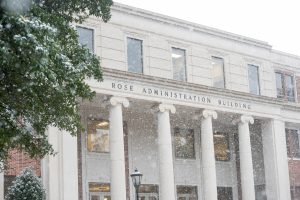
9. Rose Administration Building
Built in 1969, Rose Administration Building houses UA’s executive faculty and staff, including the president, vice presidents and provost. The building was named in honor of Frank Anthony Rose, the University’s 21st president, who oversaw the successful integration of campus.
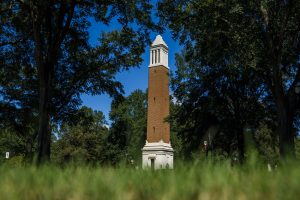
8. Denny Chimes/The Quad
Standing on the center edge of the Quad directly across from the President’s Mansion is a 115-foot-tall tower that has been the iconic symbol of the University since it was dedicated in 1929 in honor of Dr. George H. Denny, president of the Capstone from 1912 to 1936, and again in 1941. On UA football game days, popular melodies can be heard as select students or faculty play the modified organ inside the tower.
The 22-acre Quad is bordered with two-thirds of a mile of sidewalks and is dotted with ancient shade trees. The open areas are perfect for Frisbee games, picnics and sunbathing.
7. Foster Auditorium
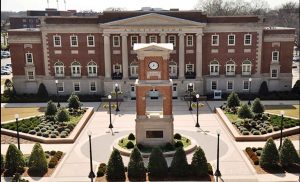
Declared a National Historic Landmark in 2005, Foster Auditorium is the site where two black students, James Hood and Vivian Malone, attempted to integrate the University on June 11, 1963. They were temporarily blocked from enrolling by Gov. George C. Wallace, who made a “stand in the schoolhouse door” in keeping his pledge made a few months prior that the state would remain forever segregated. That same day, the Alabama National Guard was federalized by President John F. Kennedy and was called to the scene to safely escort the two students into the auditorium, where they enrolled.
Today, the auditorium houses the volleyball program, and overlooks the Malone-Hood Plaza and Autherine Lucy Clock Tower, both of which commemorate the University’s integration.
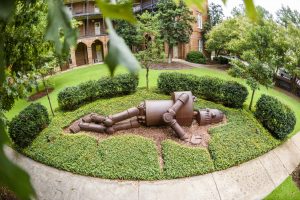
6. Woods Quad
Used as a drill field in the 1870s, Woods Quad since the 1990s has become the display area for the Woods Quad Outdoor Sculpture Garden. Pictured here is the sleeping giant robot Goldie, whose rusty, 23-foot-long body has lain on its side since 2009.
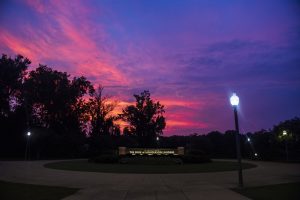
5. Manderson Landing
Located on the Black Warrior River, the 4 acres that make up the Park at Manderson Landing were transferred to the University from the federal government in 2009 – the first time the Federal Lands to Parks Program transferred property to an institute of higher learning. The park has trails, benches and grills.
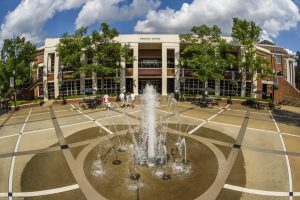
4. Ferguson Center Fountain
In the courtyard between the Ferguson Student Center and the Student Services Center is a fountain that springs forth from the ground with no pool or basin. The fountain can be programmed to shoot out in choreographed jets, creating elaborate patterns sure to entertain.
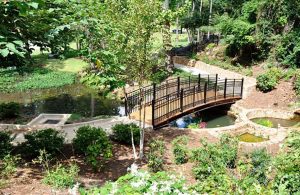
3. Marr’s Spring
Located behind the Student Services Center, this spring was the University’s original water source and a significant reason UA’s founders chose the site for the University’s home. In 1955 the spring produced 100 gallons of clean water per minute.
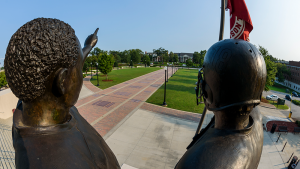
2. Bryant-Denny Stadium and the Walk of Champions
In all of college football, few gladiatorial arenas top the list of legendary locations where the best-of-the-best gridiron warriors clash. Bryant-Denny Stadium is one of them. The Crimson Tide has established a dominant 252-53-3 record at home. With seven expansions from 1946 to 2010, the stadium’s official capacity is 101,821 people, making Bryant-Denny one of the nation’s 10 largest football stadiums.
Outside the stadium at the Walk of Champions, 9-foot-tall bronze statues of Wallace Wade, Frank Thomas, Paul “Bear” Bryant, Gene Stallings and Nick Saban — the Crimson Tide’s five championship-winning football coaches — loom over onlookers and bear engravings that mark the years of our 17 national championships.
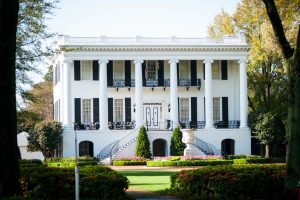
1. The President’s Mansion
Directly across from Denny Chimes sits the President’s Mansion. Built between 1839 and 1841, and one of the few campus buildings to survive the Civil War, this Greek Revival-style home with its sweeping front staircase has been on the National Register of Historic Places since 1972. It has served as home to University presidents and their families for nearly two centuries. UA’s groundskeepers take meticulous care of the lawn, which on fall Saturdays is covered in white tents for presidential receptions. In spring, UA seniors in cap and gown and high school students headed to prom make their way to the lawn for photos.
